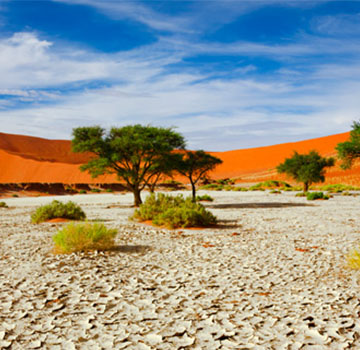Mining remains the mainstay of Namibia’s economy, being the largest contributor to the GDP. Namibia is the fourth largest exporter of non-fuel minerals in Africa and the world’s fifth largest producer of uranium. Rich alluvial diamond deposits make Namibia a primary source for gem-quality diamonds. Namibia also produces large quantities of lead, zinc, tin, silver, and tungsten.
(i) livestock, beef and mutton production, which accounts for about 70-80% of the gross agricultural income; and (ii) agronomic production which accounts for the remaining 20-30% gross agricultural income.
The livestock population of Namibia is about 2.5 million cattle, 2.4 million sheep and 1.8 million goats. The major cattle breeds are the well adapted indigenous Sanga as well as Bonsmara, Afrikaner, Brahman and Simmentaler breeds. Cattle farming is concentrated in the northern and central parts of the country where a variety of breeds freely roam the nutritious grasslands, whilst sheep farming is mainly in the southern part of the country. About 80% of Namibia's beef and mutton is exported to South Africa and the European Union. Namibia's climate is mainly suitable for dry-land crop production, with the exception of areas in the north, north-eastern, and southern parts of the country where irrigation is possible in areas bordering perennial rivers and where dams feed irrigation schemes.
The main crops grown are maize, wheat, sorghum, pearl millet, grapes, dates and a variety of beans. Namibia remains a net importer of basic food crops particularly from South Africa and in 2005 the country imported 50% of the cereals it required. To address the dependency on imports, the government is acquiring land from traditional authorities, mainly from areas where irrigation is possible, for crop production under the Green Scheme Programme.
In terms of the Green Scheme Policy, government enters into a public private partnership (PPP) agreement with a private investor who is given the mandate to farm the land, with the government being in charge of providing bulk services i.e. access to roads, water and electricity.
The government's land reform policy is shaped by two key pieces of legislation: the Agricultural (Commercial) Land Reform Act 6 of 1995 and the Communal Land Reform Act 5 of 2002. The government remains committed to a "willing seller, willing buyer" approach to land reform and to providing just compensation as explicitly stipulated and directed by the Namibian constitution.













 Bank of Namibia Economic Outlook February 2010
Bank of Namibia Economic Outlook February 2010
 Bank of Namibia
Bank of Namibia
